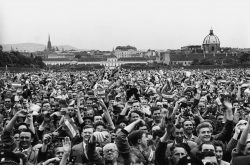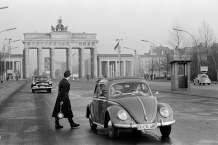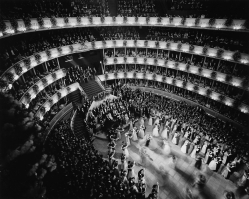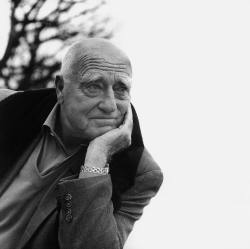Media
UMAG Photography Exhibition:
“Erich Lessing: The Pulse of Time—Capturing Social Change in Post-war Europe”
26 Nov 2015
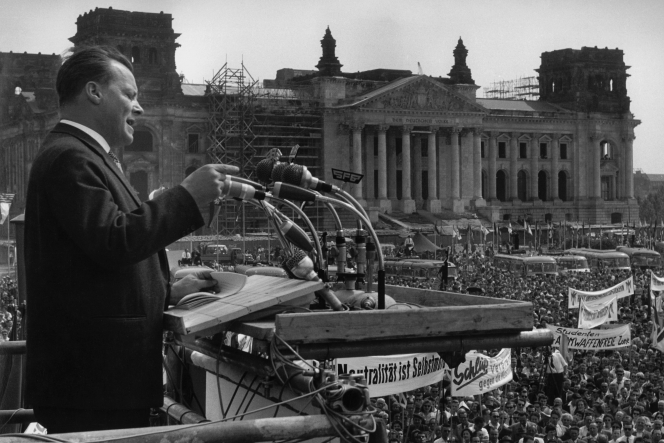
The Mayor of Berlin, Willy Brandt, speaks to Berliners, 1959
(Photography: ERICH LESSING | © Photographs by Erich Lessing)
The University Museum and Art Gallery (UMAG) is collaborating with the Austrian Consulate for Hong Kong and Macau and the Erich Lessing Archive on an exhibit of work by the celebrated Magnum photographer Erich Lessing.
An opening ceremony of the exhibition was held at UMAG today (November 26). Officiating guests included Consul General, Austrian Consulate General in Hong Kong and Macao Dr Claudia Reinprecht; Secretary General, National Fund of the Republic of Austria for Victims of National Socialism Ms Hannah Lessing; Director, Strategy Ltd and Non-Executive Director, Chinney Alliance Group Ltd Ms Wendy Gan; HKU Vice-President and Pro-Vice-Chancellor (Institutional Advancement) Mr Douglas So and Director of UMAG Dr Florian Knothe.
The Pulse of Time includes nearly 100 documentary images from the pinnacle of Lessing’s career in the 1950s and 1960s. These images illustrate the journalist’s ability to have been working in the right place at the right time. Lessing reported on many of the most significant political events in post-war Europe, and his, now iconic, photographs record social and economic changes in ever developing societies in both eastern and western Europe.
Some of Lessing’s works include Enthusiastic Austrians in the Park at the Belvedere, which was photographed in 1955. Bearing in mind that no other country had managed, through diplomatic channels, to alter the effects of the division of Europe after World War II, one can understand the high emotional value of the signing of the State Treaty for the general populace. Numerous legends arose around the circumstances of the treaty, and the photograph of Foreign Minister Figl displaying the document from the balcony of the Belvedere has taken on iconic status for the nation;
Traffic Check at the Brandenburg Gate (1959) shows the division of Berlin, as a border guard at the center of the Brandenburg Gate controlled the city’s residents. Before the Wall went up, moving across the border was relatively easy, as a number of people worked in the West but lived under cheaper leases in the East. Many, especially better-educated people, took advantage of this situation to escape from East Germany before the Wall was constructed in 1961.
The tradition of the VIENNA OPERA BALL (1960) dates back to the early 19th century. The tradition continued even after the end of the monarchy, and was only interrupted during the Second World War and the immediate post-war years. The first ball took place after the war on 9 February 1956..
All exhibition-related activities will be held at 1/F, T.T.Tsui Building, UMAG, HKU, 90 Bonham Road, Pokfulam
Erich Lessing
Born in 1923, Erich Lessing began working for the Associated Press in 1947, and joined Magnum Photos as one of its first members in 1951. Commissioned primarily for LIFE, Paris Match, Picture Post, EPOCA and Quick Magazine, he documented political events in post-war Europe, primarily in the former Communist countries. Among his most famous campaigns were coverage of the Hungarian Revolution in 1956 and French President Charles de Gaulle’s 1958 visit to Algeria. In the 1960s, Lessing turned his eye to cultural subjects such as art, science and history—taking portraits of actors, poets, musicians, physicists and astronomers. Including this series of cultural figures, Lessing has produced more than 40 books and his entire oeuvre is meticulously documented in the Lessing Photo Archive, which was established in 1996.
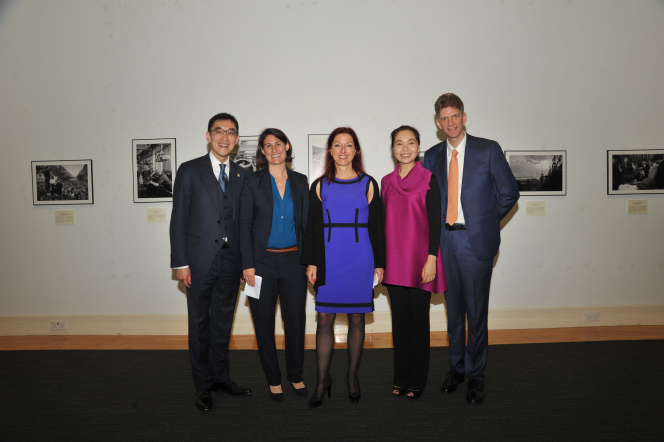
(From left) Mr Douglas So, Vice-President and Pro-Vice-Chancellor (Institutional Advancement), HKU; Dr Claudia Reinprecht, Consul General, Austrian Consulate General in Hong Kong and Macao; Ms Hannah Lessing, Secretary General, National Fund of the Republic of Austria for Victims of National Socialism; Ms Wendy Gan, Director, Strategy Ltd and Non-Executive Director, Chinney Alliance Group Ltd; and Dr. Florian Knothe, Director of UMAG, HKU.
For more photos by Lessing at the exhibition, please click here.
Public guided tour
English Guided Tours:
December 17, 2015 & January 7, 2016 (Thursday) – 13:30 – 14:00
February 12, 2016 (Friday) – 13:00 – 13:30
Cantonese Guided Tours:
December 19, 2015 & January 9 & 23, 2016 (Saturday) – 16:30 – 17:00
Details of the Exhibition
Period: November 27, 2015 (Friday) to February 14, 2016 (Sunday)
Opening Hours:
09:30 – 18:00 (Monday to Saturday)
13:00 – 18:00 (Sunday)
Closed on University and Public Holidays
Venue: 1/F, T.T.Tsui Building, UMAG, 90 Bonham Road, Pokfulam
Tel/Email: (852) 2241 5500 (General Enquiry) / museum@hku.hk
Admission: Free
Website: www.umag.hku.hk/en/
Connect with UMAG on social media:
Facebook: http://www.facebook.com/umag.hku
Twitter: http://twitter.com/UMAG_HKU
Weibo: @香港大學美術博物館UMAG
About University Museum and Art Gallery of the University of Hong Kong (UMAG)
UMAG was founded in 1953 as the Fung Ping Shan Museum. It was originally established as the Fung Ping Shan Library in 1932 in honour of its benefactor. For more information on UMAG, please refer to the document UMAG document.
Media enquiries:
UMAG Communication Officer Miss Elena Cheung, Tel: (852) 2241 5512, Email: elenac@hku.hk.

